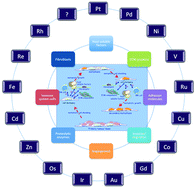Linking the future of anticancer metal-complexes to the therapy of tumour metastases
Abstract
Cancer chemotherapy is almost always applied to patients with one or more diagnosed metastases and is expected to impact these lesions, thus providing significant benefits to the patient. The outcome of metastasis is determined by the interplay between the specific subpopulation of metastatic cells and host homeostatic factors in specific microenvironments. In clinical practice, metal-based drugs are represented by platinum compounds, which are constituents of a wide variety of chemotherapeutic regimens, and are only rarely active against tumour metastases unless they are combined with drugs that target specific pathways characterizing the malignancy of the tested tumour. On experimental grounds, a number of complexes based on ruthenium and other metals have been frequently studied in vitro using models and experimental conditions mimicking one or more steps of the metastatic process, such as invasion and migration. The ruthenium-based drug, NAMI-A, is the only one to have been subject to clinical testing for the treatment of metastatic tumours. The capacity of NAMI-A to modulate the relationship established between metastatic cells and their microenvironment suggests that metal-based drugs shall be viewed as an opportunity for the treatment of tumour metastases.

- This article is part of the themed collection: Molecular Medicine and Cancer

 Please wait while we load your content...
Please wait while we load your content...